Derby Corporation Tramways
History
Under the Tramways Act of 1870, Derby Corporation had the right to purchase the local 4ft-gauge horse tramway — owned by the Derby Tramways Company — 21 years after the DTCo's enabling act, i.e., in 1900. As this date approached, the corporation began to give serious consideration to converting the horse system to electric traction, and running the tramway as a municipal enterprise. The company had been struggling for a number of years, and was certainly in no position to finance the large investment needed, so it was more than happy to negotiate a sale, especially so when it became clear that the corporation was willing to pay a fair price, rather than the scrap prices that many other councils endeavoured to obtain their local horse or steam tramway for. An agreement was signed on the 28th December 1898, with ownership to be transferred on the 1st January 1899, but with the company continuing to operate the tramway until such time as the corporation was in a position to take over.
Powers to operate the tramway were obtained on the 4th August 1899, the corporation finally taking over the running of the horse trams, as well as the ex-DTCo horse omnibuses, on the 1st November 1899. The corporation was, however, keen to build a modern municipal tramway system, and was willing to take the time to consider all options and to plan accordingly, which meant that the horse tramway would need to be kept operational for a number of years yet. Rather than simply running the tramway into the ground, the corporation set about placing the system in good running order, which included the acquisition of several second-hand tramcars and omnibuses to replace the decrepit vehicles they had inherited.
Powers to convert the horse tramway to overhead electric traction, retaining a gauge of 4ft, were acquired as part of the Derby Corporation Act of 1901, which received Royal Assent on the 17th August 1901. Work did not however start until November 1903, possibly due to the need to construct new sewers on many of the roads the tramway would follow, the first electric tramcar service commencing on the 27th July 1904. The horse trams were gradually replaced by omnibuses as conversion work proceeded, the last horse tram running on the 1st June 1907, when work began on lowering the roadway under the Great Northern Railway Company's bridge on the Ashbourne Rd line.
The corporation had therefore operated the horse tramway for just over seven and a half years. At its maximum, the system had extended to 4.68 miles, being centred on Victoria St, from where lines ran: northwestwards along Ashbourne Rd to a terminus at Windmill Hill Lane; northwards to the Market Place; southeastwards along London Rd to a terminus at Deadman's Lane, with a branch running northeastwards along Station St to the Midland Railway Company's station (Midland Station); southeastwards along Osmaston Rd to a terminus at Cotton Lane; and southwestwards along Babington Lane, then southwards along Normanton Rd to a terminus at the Normanton Hotel.
The corporation's planned electric tramway system was completed on the 8th February 1908 with the opening of the Nottingham Rd line. The system was extended twice, firstly on the 30th July 1908 (along Burton Rd) and 15 years later on 4th August 1923 (along Osmaston Rd from the Abingdon St terminus to the junction with Osmaston Park Rd).
The tramway was well-planned, and thrived accordingly, though the narrow streets that it had to negotiate were to become a serious cause of concern, particularly in the 1920s with the advent of private car ownership. Like most tramways in the British Isles, Derby's suffered during the Great War from a loss of men (and skills), which together with difficulties sourcing spares and stringent war-time restrictions on the purchase of tramcars and track, meant that only the bare minimum could be done in terms of maintenance. As a result, the tramway emerged from the conflict in badly run-down condition. In spite of the challenges posed by the post-war economy, the corporation nevertheless found the money to invest in the system, renewing worn-out track, purchasing a total of 28 new tramcars between 1920 and 1928, and top-covering others.
The last tramway extension was opened in 1923, which took the electric system to its maximum extent of 13.96 miles. As in horse-tram days, the system was centred on Victoria St, with lines running: northwestwards along Ashbourne Rd to a terminus at Windmill Hill Lane, with a line branching off southwestwards along Uttoxeter Rd to a terminus at Constables Lane; northwards through the Market Place, then northwestwards along Kedleston Rd to a terminus at Penny Long Lane, with a line branching off northeastwards at the Market Place along Derwent St, then eastwards along Nottingham Rd to the Cemetery; southeastwards along London Rd to a terminus at Alvaston (the Harrington Arms), with a branch running northeastwards along Station St to the Midland Station; southeastwards along Osmaston Rd to a terminus at the Mitre, with a connecting line running along Bateman St to join the London Rd line; southwestwards along Babington Lane, where the line divided, one route running southwards along Normanton Rd to Cavendish, where it then turned northeastwards — via Dairyhouse Rd and Douglas St — to join the Osmaston Rd line; the other route running southwestwards along Burton Rd to the borough boundary.
The corporation finally ran its last horse bus service on the 19th May 1917, a battery-electric bus taking over the next day; this lasted in turn until the 30th June 1924, when it was replaced by the corporation's first modern motorbus. With new housing estates being built away from the city centre, the corporation opted to introduce motorbuses rather than extend or build new tram lines. With the rise of the suburbs, motorbus services expanded significantly throughout the latter half of the 1920s, several of them extracting passengers from the tramway. The success of the new motorbus services, coupled with the impending need for major track renewals, inevitably precipitated a discussion on the way forward, the council deciding — on the 21st August 1929 — to gradually abandon the tramway, though it was to be the following year before it was decided to replace the trams with trolleybuses.
Powers were acquired to abandon the tramway and operate trolleybuses in 1930, the first tramway casualty being the Nottingham Rd line, which closed on the 14th November 1930; services initially being provided by motorbuses until the trolleybuses were ready to take over, which they did on the 9th January 1932.
As more trolleybuses arrived, conversion proceeded, more closures taking place in 1932, 1933 and 1934, the last tram of all running on the 2nd July 1934.
Like many small municipal systems, the tramway was relatively successful until the advent of the motorbus and the growth of the suburbs, which it did not serve. Although the tramway carried a large number of passengers during its lifetime (445 million), the low fares and short journeys meant that it was always going to struggle to pay off the debt, let alone set aside enough for renewals. By the time of the 1929 debate, the debt was a staggering £250,000, which though large, was not uncommon, as many councils had either kept fares artificially low, or used the profits their tramway made to subsidise the rates. It is unclear what happened in Derby, though the consequence of the large debt was a decision to opt for what the council saw as a cheaper and more modern option, rather than a much more expensive tramway renewal.
Uniforms
Following its takeover of the Derby Tramways Company's system, the corporation issued staff working the horsecar services with drooping-peak caps, which bore script-lettering grade badges — either 'Conductor' or 'Driver' — above which individual system initials ('D C T') were sometimes worn; it is possible, though by no means certain, that the badges were brass. The earliest corporation-era photos show tramcar crews wearing the distinctive long overcoats (with dark collars) of the DTCo. Horsecar crews were, however, eventually issued with a new design of double-breasted greatcoat bearing five pairs of buttons and high fold-over collars; the latter bore a badge, almost certainly incorporating the Derby 'buck in the park' municipal device, again possibly in brass. The buttons on these garments may well have been of an untitled Derby Corporation pattern (see link) rather than the titled 'DERBY CORPORATION TRAMWAYS' buttons that were used when electric services commenced. Photographs of horsecar crews taken after 1904 show that they were eventually provided with the same double-breasted jackets and tensioned-crown peaked caps as their colleagues working the new electric trams.
Electric tramcar crews were issued with double-breasted jackets with four pairs of buttons (probably nickel, and bearing the full system title and municipal device — see link), and lapels; the jacket collars bore individual letters on both sides — ‘D C T’ — presumably in nickel to match the buttons. The tensioned-crown peaked caps bore standard, off-the-shelf, script-lettering grade badges (either 'Driver' or 'Conductor'), above which a municipal-device badge was worn (see below for an example). The 'Driver' grade badges were eventually superseded by their 'Motorman' equivalents, probably in the mid-to-late Edwardian era.
Between the Edwardian era and the Great War, conductors and motormen were required to wear oval metal armbands — presumably municipal licence badges — and probably made of a light alloy. In the case of conductors, these bore the grade — 'CONDUCTOR' — and a number (in the middle), surrounded by 'BOROUGH OF DERBY TRAMWAYS'. The motorman's equivalent probably bore the grade 'DRIVER', though confirmation must await the discovery of new photographic evidence or a surviving example.
At some point (probably around the time of the Great War), the style of the jackets was subtly altered, and though still double-breasted, the top set of buttons were now usually buttoned through the lapels (see photos below); the jackets appear to have initially borne four pairs of buttons, though this was for a relatively short time, being superseded by a similar style with five pairs. Further changes were made in the last few years of the system, with the left-hand collar now carrying an employee number, and a switch from individual system initials to a one-piece 'DCT' badge. The tensioned-crown peaked caps also appear to have been changed around this time, to ones with a woven-straw tops.
Tramcar crews were also issued with long, double-breasted greatcoats with five pairs of buttons and high, fold-over collars; the latter carried the standard 'buck in the park' municipal-device badge on both sides. The occasional photo shows motormen wearing capes, which were presumably official issues.
In the early years of municipal ownership, inspectors were issued with single-breasted jackets with hidden buttons (or more likely an hook and eye affair) and stand-up collars; the latter carried the initials ‘D C T’ in embroidered block-capitals on both sides. The jacket and the pockets were finished off by edging in a different (silk-like) material, which was also applied to the trousers in the form of a stripe. Caps were of the drooping-peak type; they bore a large oval cloth badge containing embroidered script initials, ‘D C T’, above ‘INSPECTOR’ (in block capitals). The style of uniform worn by inspectors in later years is currently unknown.
In common with the vast majority of UK tramway systems, Derby employed female staff during the Great War to replace men lost to the armed services. The first of these ladies were taken on in 1915, and by September 1916 they numbered 62, all conductresses; they worked through the war and well into 1919, the remaining 51 being released on the 1st November 1919. These ladies were issued with tailored, single-breasted jackets with four buttons, a waist belt with button fastening, two breast and two hip-level pockets (with button closures), epaulettes and high fold-over collars. Unlike the mens' jackets, the ladies' jackets did not carry any insignia. Two types of cap are known: soft-topped baggy motor caps with glossy peaks; and wide-crown peaked caps. Both types of cap bore the same badges as the men's caps, i.e., a script-lettering grade badge and a municipal-device badge.
Further reading
For more information on Derby Corporation Tramways, see: 'The Story of Transport in Derby' by Barry Edwards; The Breedon Books Publishing Company (1993).
Images
Horse Tram drivers and conductors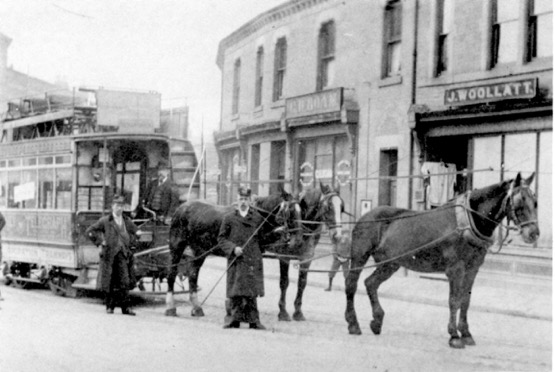
An unidentified horse tram crew pose outside the Normanton Hotel in Normanton Road — photo probably taken very shortly after the corporation take-over of November 1899. Photo courtesy of the Tramways and Light Railway Society, with thanks to David Voice.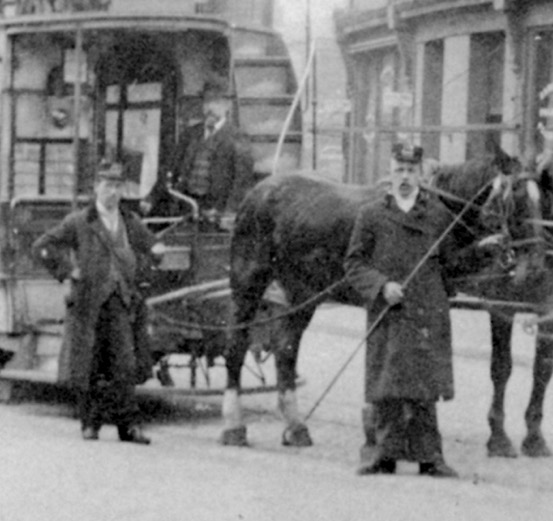
An enlargement of the above photograph showing the conductor (left), the driver (on the platform) and a trace-horse or 'link' man (right) who is holding a hook for quickly attaching and detaching his trace horse. The conductor and the link man are both wearing the old Derby Tramways Company greatcoats, but with new corporation-issued drooping-peak caps.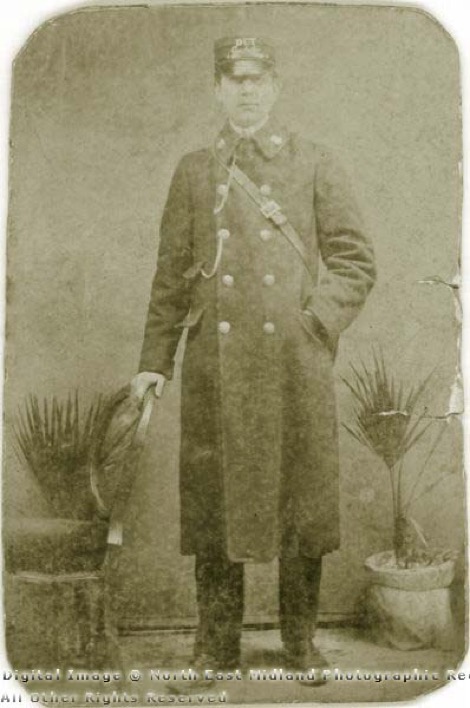
A studio portrait of conductor Harrison Fletcher — photo undated, but probably taken around 1903. It is likely that Mr Harrison was a conductor on the horse trams at the time (these only ceased running in 1907), as he is wearing a drooping-peak cap, whereas photos of electric tramcar crews (from 1904 onwards) show them wearing tensioned-crown peaked caps and double-breasted jackets. The collar badges are probably the stylised Derby municipal-device badge shown below. Photo with kind permission of the North East Midland Photographic Record at ‘Picture the Past’.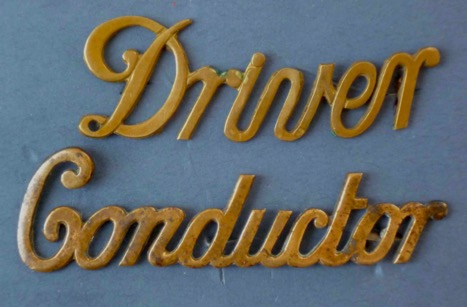
General pattern script-lettering grade badges of the type used on DCT horse-tram crew caps — brass. 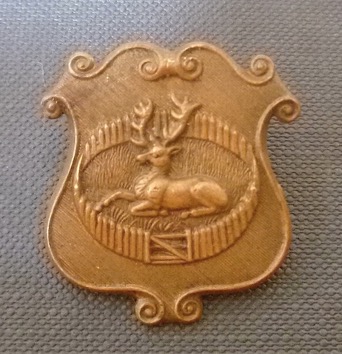
Derby Corporation municipal-device badge, bearing the so-called 'buck in the park' — brass. This was probably the same patter on badge worn on the collars of horsecar-crew greatcoats. Author's Collection.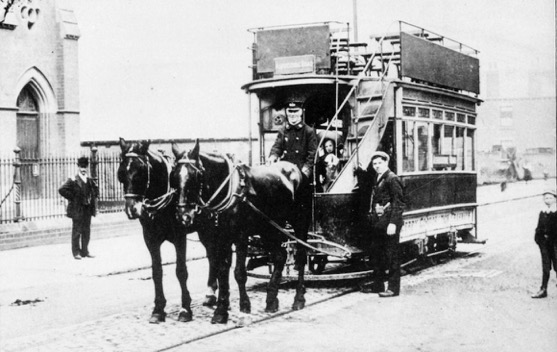
An ex-Glasgow horsecar stands on Ashbourne Road — photo undated, but certainly taken between 1903 and 1907. Photo courtesy of the Tramways and Light Railway Society, with thanks to David Voice.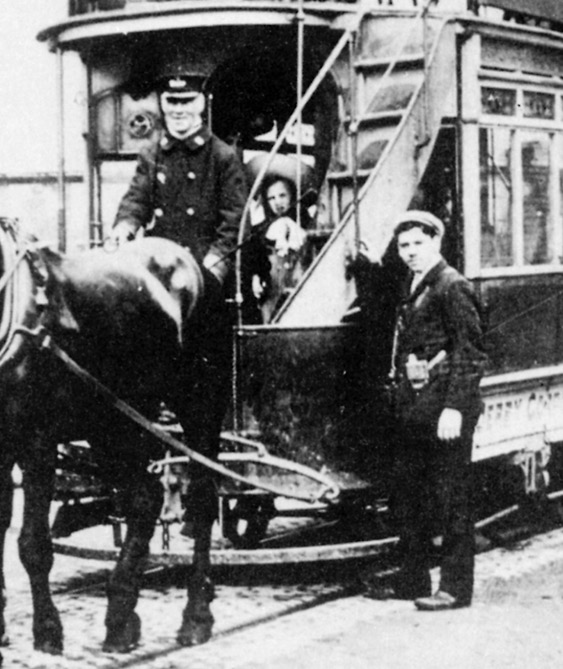
An enlargement of the above photograph showing the crew. The conductor is wearing informal attire, including a flat cap, whereas the driver is wearing a corporation-issued greatcoat and a tensioned-crown peaked cap.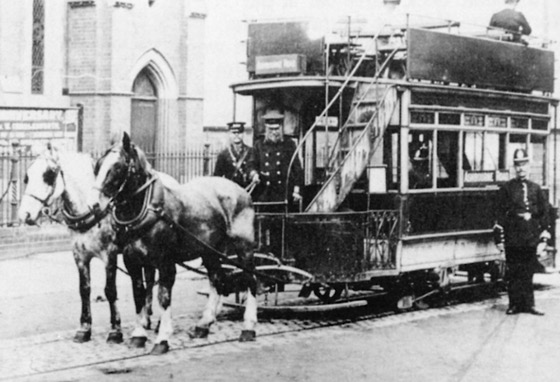
Another photo taken at the same location as the previous image — undated, but probably taken after 1903 as the conductor is wearing a double-breasted jacket of the same type issued to electric tramcar crews. Both men are also wearing tensioned-crown peaked caps rather than the early drooping-peak caps. Photo courtesy of the Tramways and Light Railway Society, with thanks to David Voice.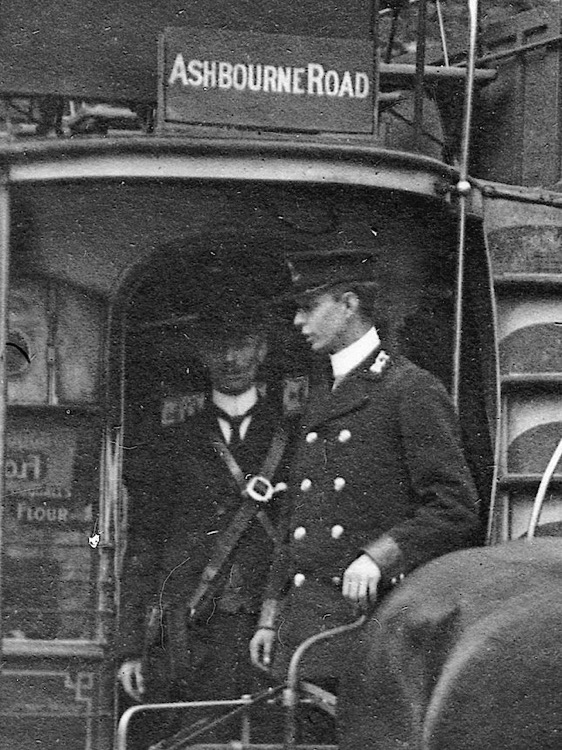
A driver and a conductor on the platform of Tramcar No 22 (ex-Glasgow) in Ashbourne Road — photo undated, but certainly taken between 1903 and 1907. The driver's left-hand collar bears 'D C T' system initials. Photo courtesy of the National Tramway Museum. 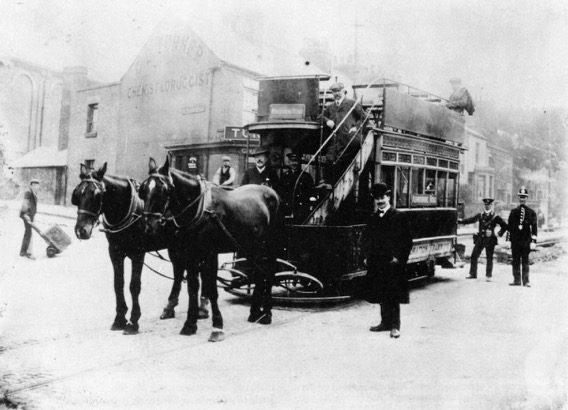
A posed photo of Tramcar No 22, once again on Ashbourne Road at the junction of Surrey Street (seemingly a favoured photographic location) — probably taken in the last few months or even weeks, before closure (the road behind the tram has been excavated for the new track). Photo by Mr C Dakin Turner, courtesy of the Tramways and Light Railway Society, with thanks to David Voice.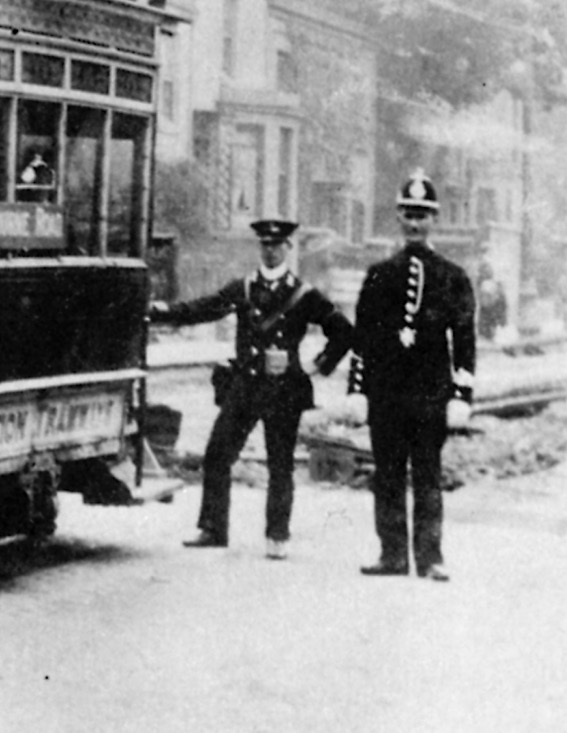
An enlargement of the above photograph showing the conductor, in double-breasted jacket and tensioned-crown peaked cap.
Motormen and conductors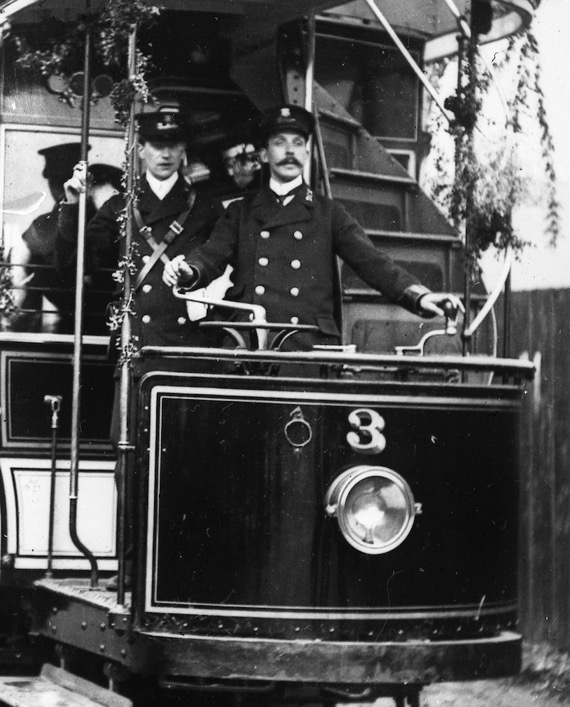
The crew of Tramcar No 3, decorated for the occasion, pose for the cameraman on the opening day of the new electric services (27th July 1904); both men are wearing double-breasted jackets with lapels, and tensioned-crown peaked caps bearing a shield-shaped municipal-device badge and a grade badge ('Driver' and 'Conductor'). Photo courtesy of the National Tramway Museum. 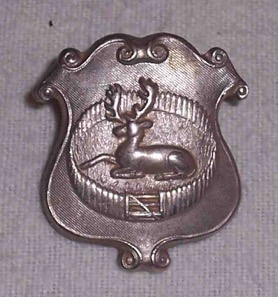
Derby Corporation municipal-device badge — nickel. This was worn on tramcar crew caps from the inauguration of electric services right through to their withdrawal. Note the absence of stag supporters to the shield, the granting of which post dates the demise of the tramway. Author's Collection.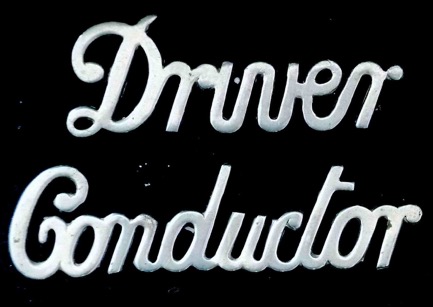
Standard off-the-shelf script-lettering grade badges of the type used on electric tramcar-crew caps from 1904 to around the time of the Great War — nickel. Author's Collection.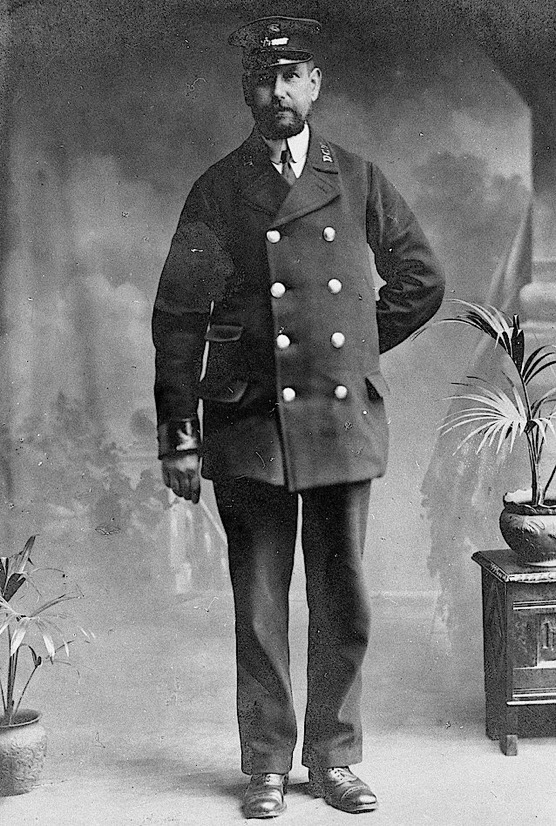
Derby Corporation Tramways motorman, William Henry Tomlinson — photo undated, but probably taken around the time of electrification. Mr Tomlinson had been a horse tram driver. His collars bear individual 'D C T' initials on both sides. Photo courtesy of the National Tramway Museum.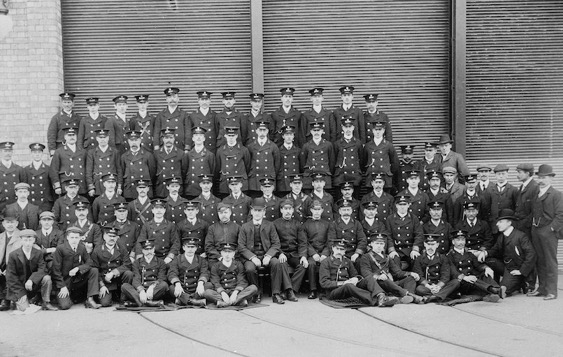
DCT staff assembled for an official photo at Abingdon Road depot — photo undated, but probably taken to mark the inauguration of electric services. Photo courtesy of the National Tramway Museum.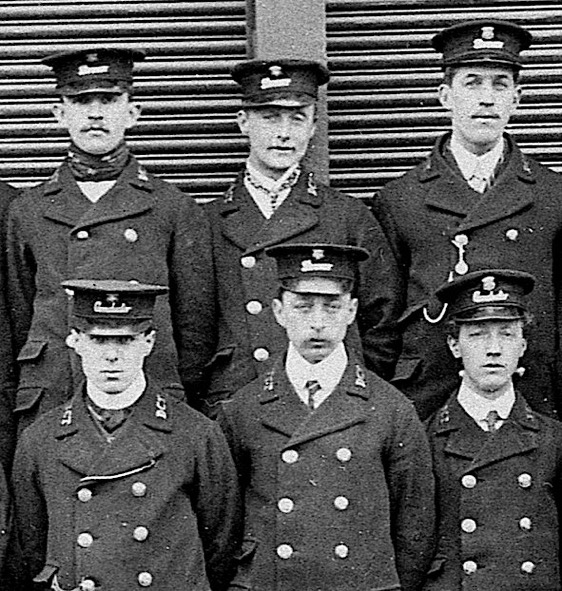
An enlargement of the above photograph showing four of the motormen and two of the conductors.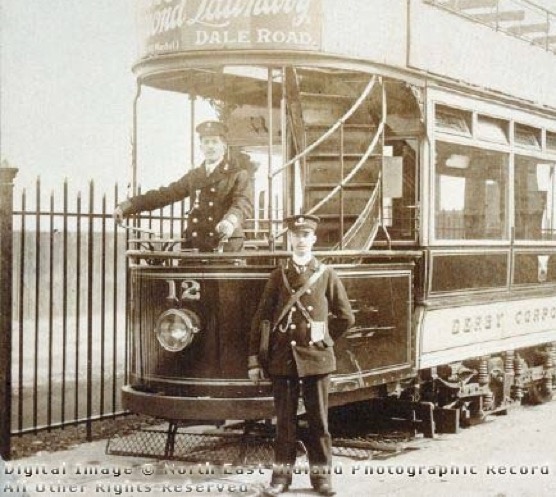
A motorman and a conductor pictured in 1904 with Tramcar No 12 at Abingdon Road depot. Photo with kind permission of Derby City Council at ‘Picture the Past’.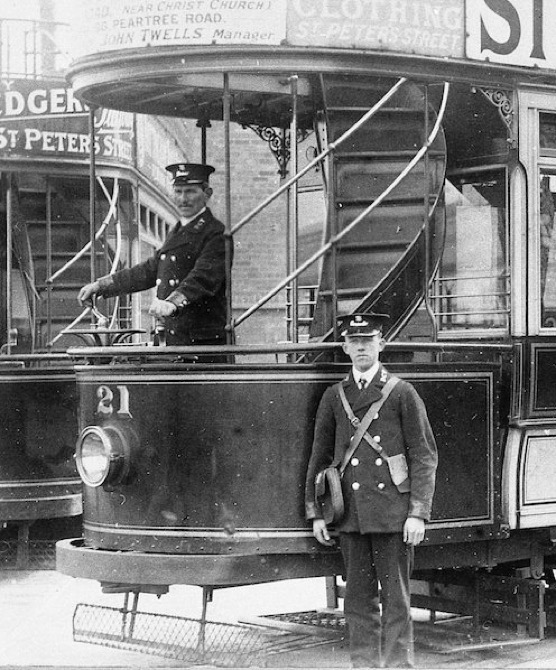
A depot shot of Tramcar No 21 and crew — photo undated, but probably taken in the mid-to-late Edwardian era. Photo courtesy of the National Tramway Museum.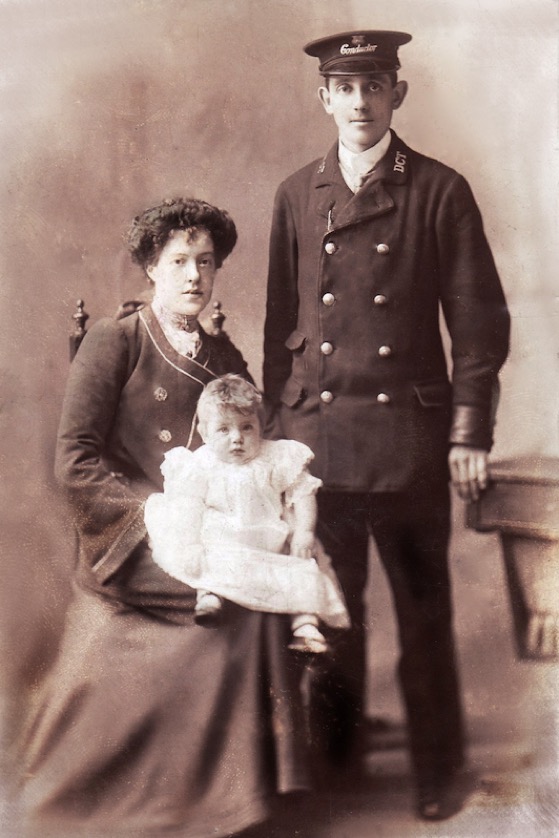
A DCT conductor with his wife and young daughter (presumably) — photo undated, but probably mid-to-late Edwardian. Photo courtesy of Mike Perkins.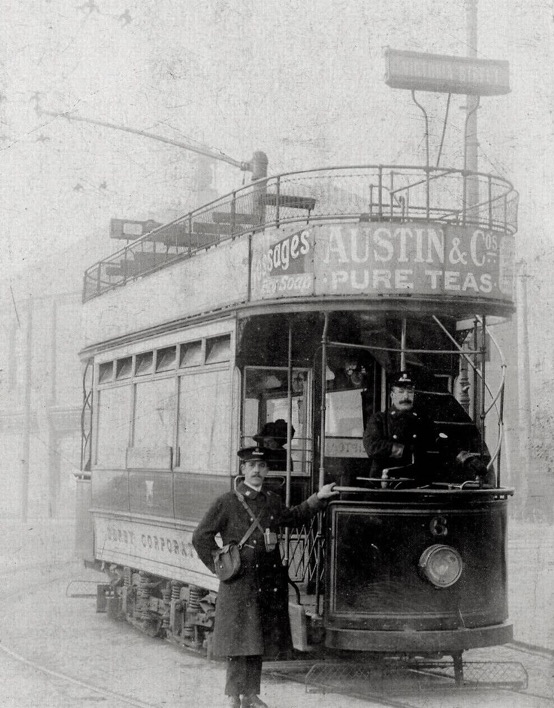
Tramcar No 6 and its crew, both in double-breasted greatcoats, with a service to Victoria Street — photo undated, but judging by the excellent condition of the tram, probably mid-to-late Edwardian. The motorman is wearing a licence badge on his left greatcoat sleeve. Source unknown.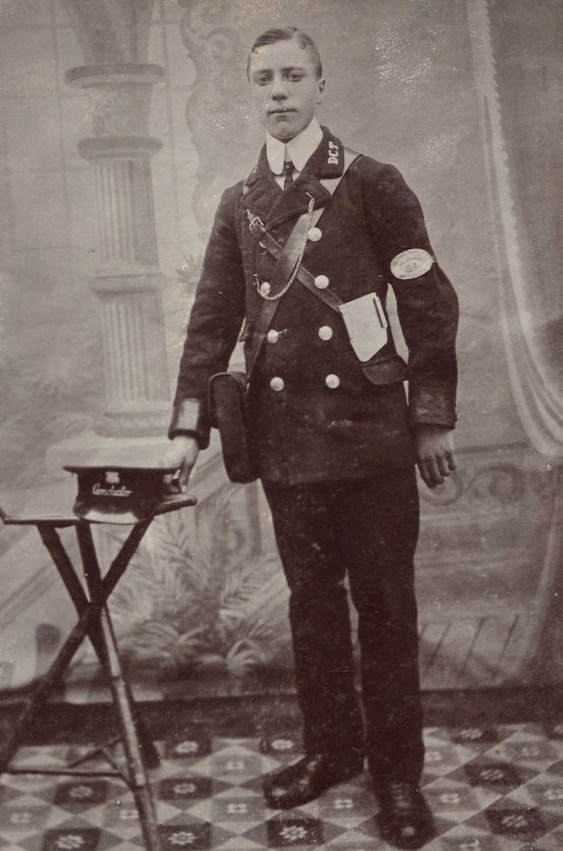
A fine studio portrait of a DCT conductor, wearing an armband that is rarely seen in other photographs, suggesting that it may only have been worn for a short period — photo undated, but from the tall shirt collar, probably taken between 1910 and the Great War. Author's Collection.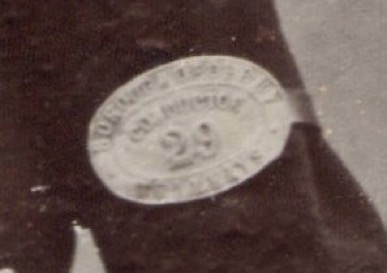
An enlargement of the armband above, revealing it to read: 'Borough of Derby Tramways — Conductor 29'.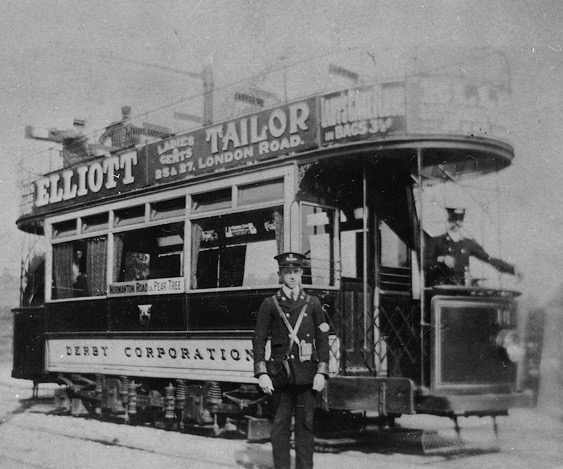
The crew of Tramcar No 16 — photo undated, but probably taken around the time of the Great War. Photo courtesy of the National Tramway Museum.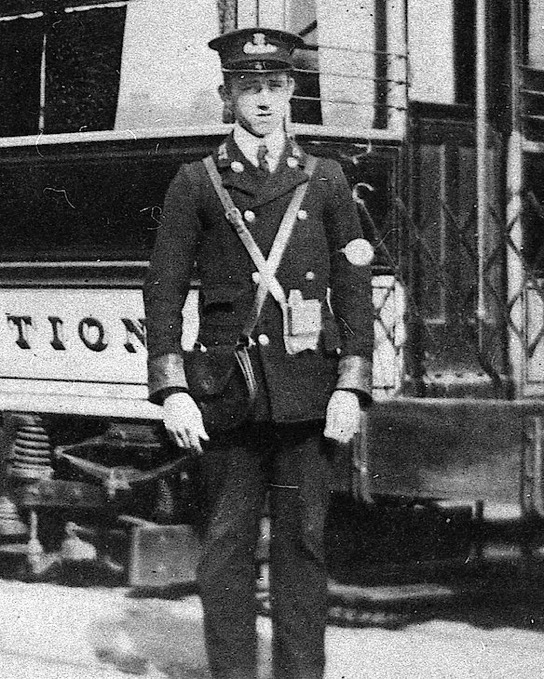
An enlargement of the above photograph showing the conductor, who is clearly wearing an armband on his left sleeve.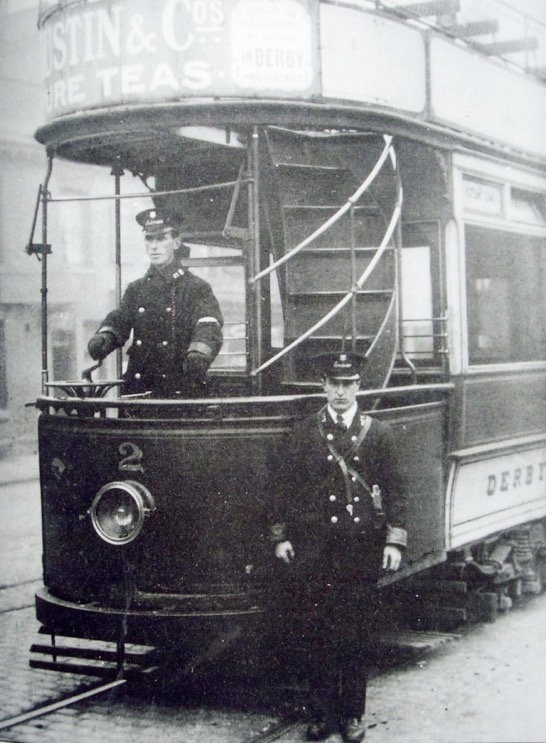
The crew of Tramcar No 2 pose rather stiffly for the camera — photo undated, but probably taken around the time of the Great War. The motorman, Rowland Salt, is wearing an armband, though there is no sign of one on his colleague's jacket. Photo courtesy of the Stephen Howarth Collection.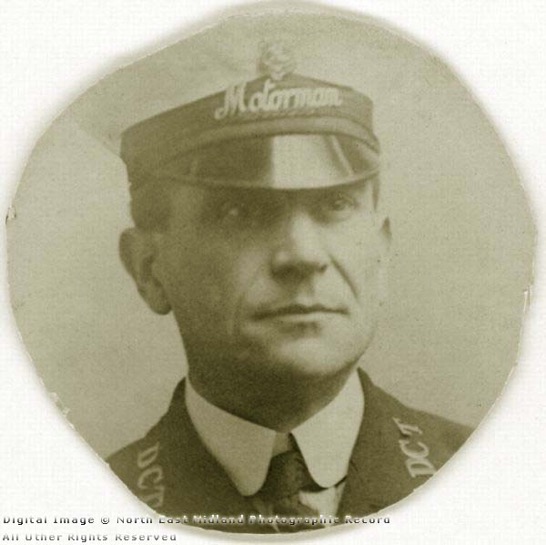
Harrison Fletcher, now a motorman (date unknown, but probably taken around the time of the Great War); he was certainly a motorman by 1908, as a photo exists of him in that year at the controls of a Derby tram. By this time, a switch had clearly been made from 'Driver' grade badges to their 'Motorman' equivalents. Photo with kind permission of the North East Midland Photographic Record at ‘Picture the Past’.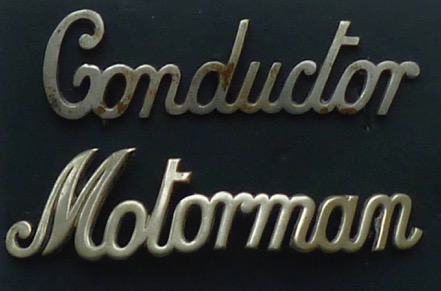
Standard off-the-shelf script-lettering grade badges of the type used on DCT electric tramcar-crew caps from around the time of the Great War through to closure (1934) — nickel. Author's Collection.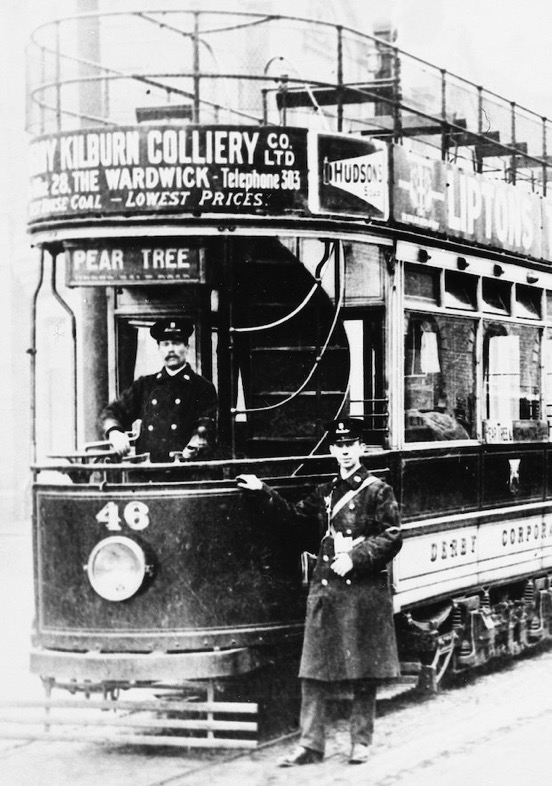
A poor quality photograph of Tramcar No 46, though one which shows a crew in greatcoats — photo undated, but probably taken around the time of the Great War. Photo courtesy of the National Tramway Museum.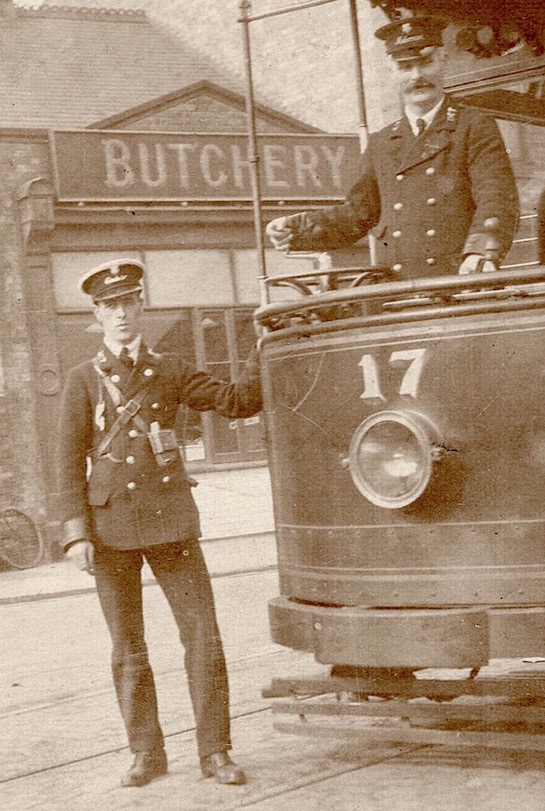
A conductor and a motorman with Tramcar No 17 at a location that remains to be identified — unusually, the photo is precisely dated: 9th September 1922. Author's Collection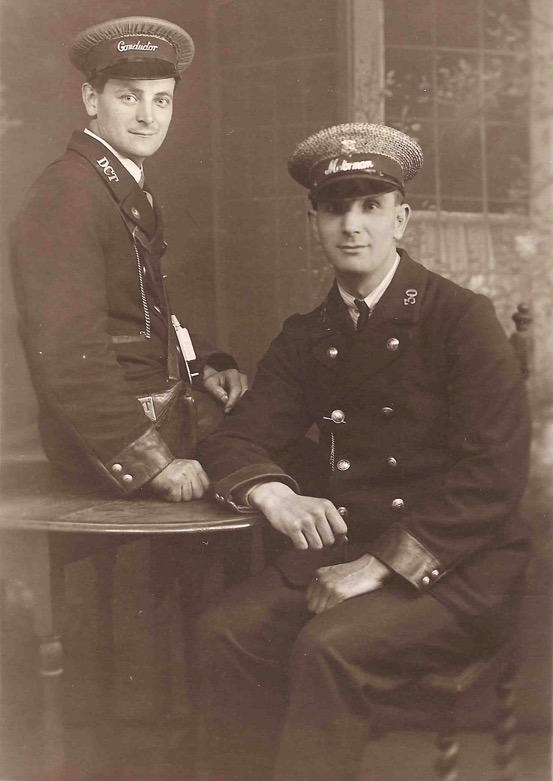
A studio portrait of a conductor and a motorman — date unknown, but probably taken in the late 1920s. The motorman is wearing a municipal-device badge above his grade badge, whilst the conductor is not, though it may well be hidden by the rain cover. Author's Collection.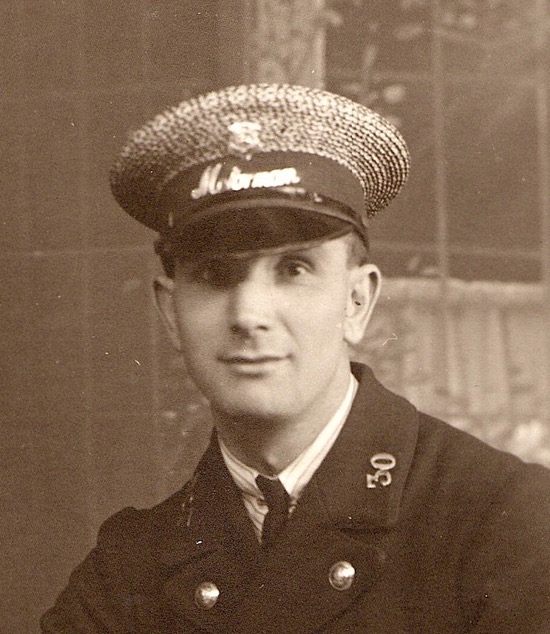
An enlargement of the above photograph showing the motorman (Employee No 30), who is wearing a cap with a woven-straw crown (top). This style of cap was purportedly more comfortable, with better ventilation.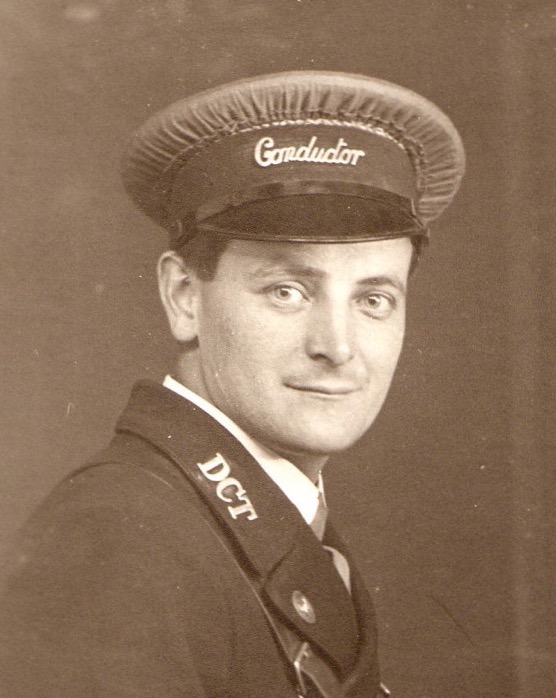
Another enlargement of the above photograph, this time showing the conductor. The 'DCT' collar badge was by this time of one-piece construction rather than individual letters.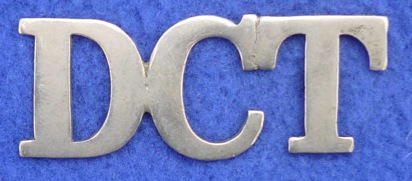
One-piece DCT collar badge — nickel. Author's Collection.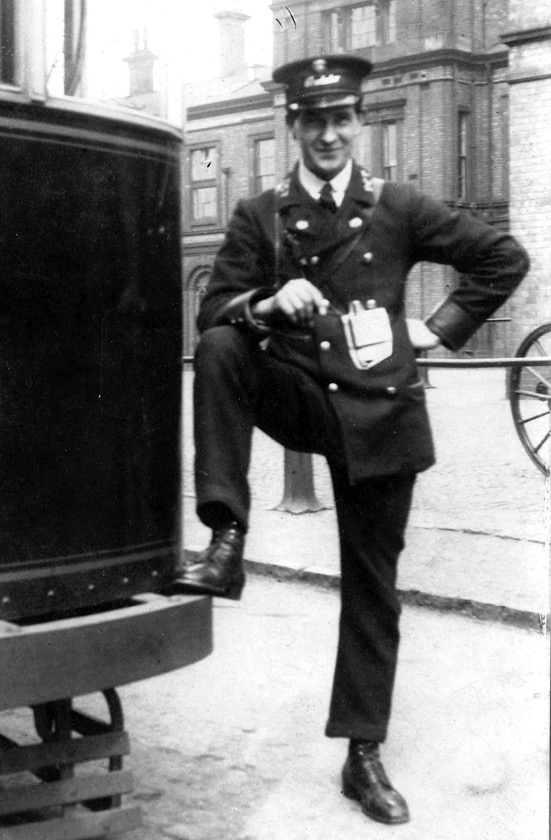
Derby Corporation Tramways conductor with Tramcar No 58 on the 17th March 1934 — possibly outside Derby Midland Station. Author's Collection.
Senior staff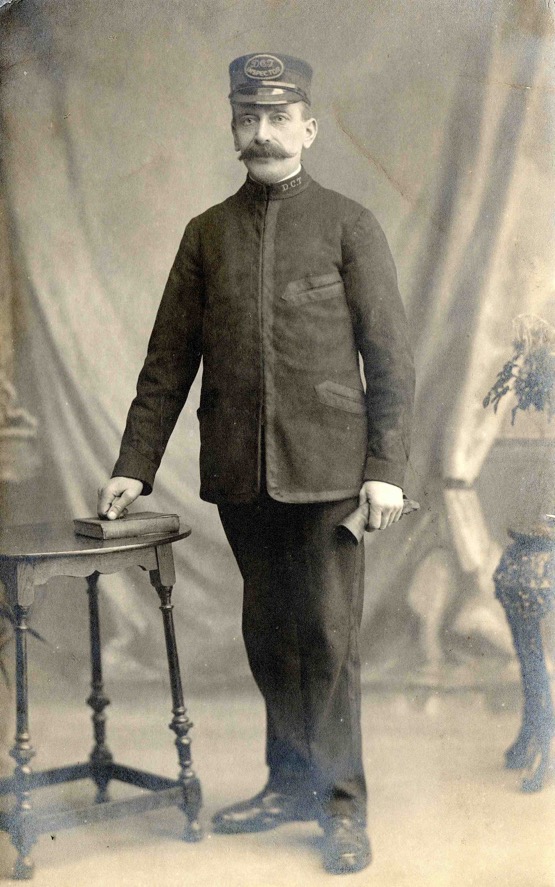
A studio portrait of a Derby Corporation Tramways inspector — photo undated, but almost certainly taken in the very early years of corporation ownership. Although there is nothing on the photo to specifically identify it as Derby, the uniform and badge are the same as those seen in photographs of other Derby Corporation Tramways inspectors. With thanks to Stephen Howarth for the identification. Author's Collection.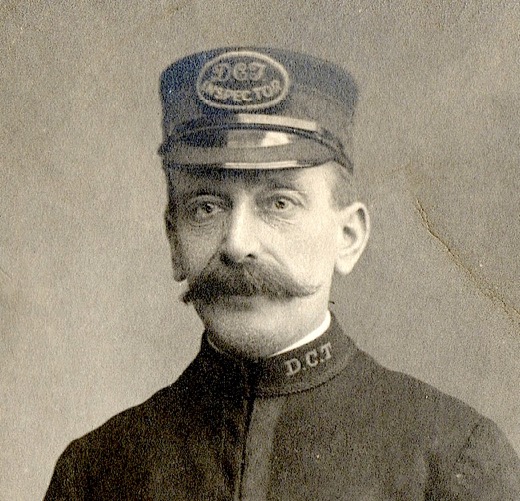
An enlargement of the above photograph showing details of the cap and collar insignia.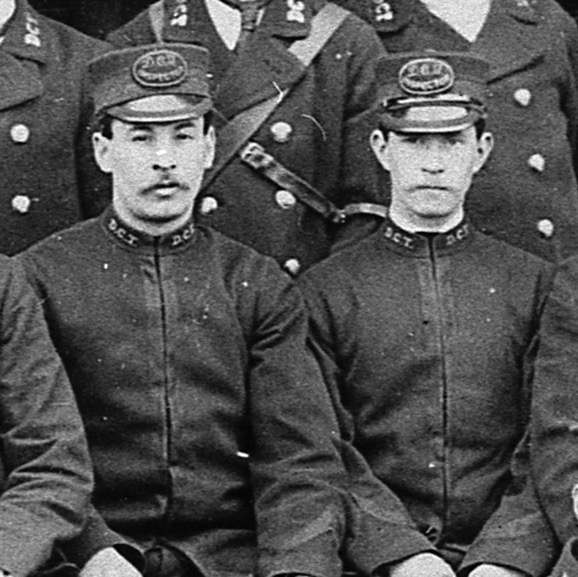
An enlargement of the Edwardian staff photograph above showing two of the inspectors.
Female staff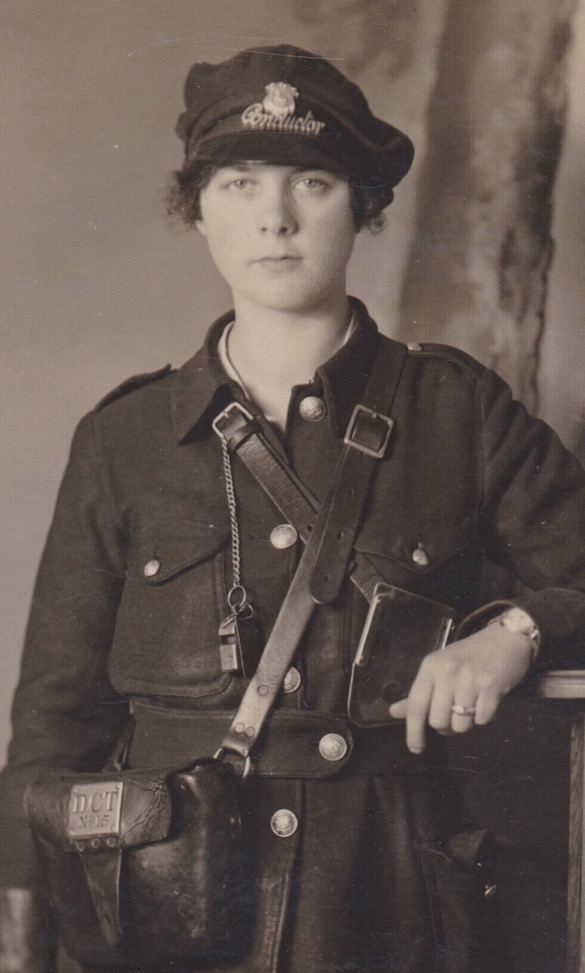
A rare image of a Great War DCT conductress, in fact, one of only two that I am aware of. The subject's baggy cap is of a type that came to be referred to as 'motor caps'. Her cash bag carries a plate bearing 'D C T No 15', which would have been a number allocated to the bag rather than the subject's employee number. Photo courtesy of the Geoff Caulton Collection.